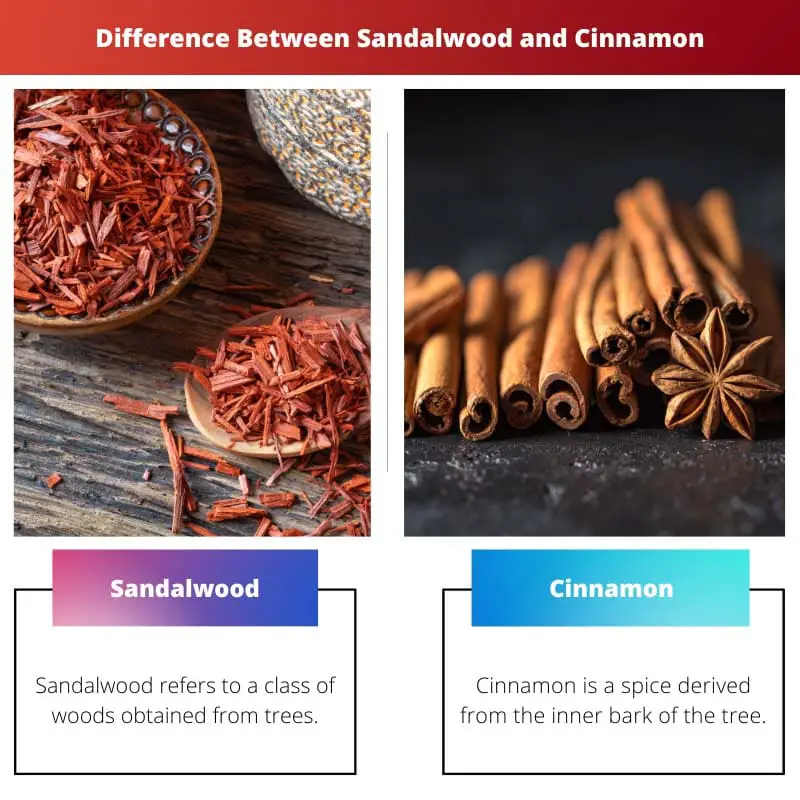Herbs and Spices have been used for various purposes since antiquity. They are primarily used as a flavouring and as a preservative in the preparation of food, but they also have certain medicinal properties.
Some herbs and spices are also used for performing religious rites, like fulfilling a religious obligation or perpetuating a superstition.
Key Takeaways
- Sandalwood is a fragrant wood from trees in the Santalum genus, used in perfumes, incense, and traditional medicine.
- Cinnamon is a spice derived from the inner bark of trees in the Cinnamomum genus, used for flavoring and medicinal purposes.
- Sandalwood is primarily valued for its aroma and therapeutic properties, while cinnamon is prized for its distinct taste and potential health benefits.
Sandalwood vs Cinnamon
Sandalwood is a type of wood which is used to make fragrances. Sandalwood is heavy and yellow in color. Sandalwood is also used in religious activities. Cinnamon is a type of spice which is obtained from a tree’s inner bark. It can be used to add flavour to eatable things. It can also be used to make fragrances.

Sandalwood denotes a category of wood obtained from the stem and roots of the hemiparasitic trees belonging to the Santalum genus.
The obtained wood is yellow, heavy, fine-grained and notably stays aromatic for decades. It is dubbed as the most expensive wood in the world.
It is used in fluorescence microscopy and as an alternative to certain ingredients, besides its use for its fragrance.
Cinnamon is a spice extracted from the inner bark of trees belonging to the Cinnamomum genus and Lauraceae flower family. It is widely used as a flavouring additive and aromatic condiment in a variety of cuisines across the world.
Its aroma and flavour are derived from its essential oil and major component called Cinnamaldehyde.
Comparison Table
| Parameters of Comparison | Sandalwood | Cinnamon |
|---|---|---|
| Scientific Name | The scientific name of Sandalwood is Santalum paniculatum. | The scientific name for Cinnamon is Cinnamomum Verum. |
| Description | Sandalwood refers to a class of woods obtained from trees. | Cinnamon is a spice derived from the inner bark of the tree. |
| Physical Properties | The woods are yellow, heavy, and fine-grained. | Cinnamon is brown, has a fragrant aroma, and is sweet to taste. |
| Native to | Sandalwood is native to islands of the South Pacific and Southeastern Asia. | Cinnamon is native to Sri Lanka, South America, the West Indies, and the Malabar Coast of India. |
| Uses | Sandalwood is used for providing fragrance, in fluorescence microscopy, and as alternatives in cooking. | It is used to flavor eatables, perfumes, and drugs. |
What is Sandalwood?
Sandalwood (Santalum paniculatum) is a yellow-colored, aromatic wood obtained from the roots and stem of trees of the Santalum genus.
Often known as ‘the most expensive wood in the world,’ it is notable for its distinctive warm, soft, and smooth aroma, which stays for decades. The yellow aromatic oil, called Sandalwood oil, forms its major constitution.
Sandalwood has been cultivated since antiquity because of its use in religious and cultural activities.
Producing commercially viable Sandalwood requires it to have high amounts of yellow Sandalwood oil, which is used in folk medicines, perfumes, incense sticks, candles, soaps, etc., after being procured through steam distillation of wood.
The yield of oil from wood depends on the location and age of the trees; usually, older trees tend to have a higher yield.
Besides its use as an aromatic agent, it is also used for aromatherapy, and its nuts are used as substitutes for a variety of ingredients like macadamia, almonds, or hazelnuts.
Because of its optimal refractive index and low fluorescence is used as immersion oil in UV and fluorescence microscopy.
Since commercially viable Sandalwood takes years to grow, some species of Sandalwood have suffered over-harvesting in the past decades due to the gap between demand and supply of the slow-growing Sandalwood.

What is Cinnamon?
Cinnamon (Cinnamomum Verum) is a spice, i.e., plant products obtained from seed, root, fruit, or bark of plants and used for garnishing and flavouring, which is used in dried and powdered form.
Brown in color, it is derived from the inner bark of Cinnamomum genus trees under the Lauraceae family. It is used for its aromatic and flavouring properties in the preparation of cuisines, drugs, perfumes, and liquor.
Historically, Cinnamon was regarded as more precious than gold. In early Egypt, people used Cinnamon for religious and embalming activities.
During medieval times, it was used for religious rites, as well as for its flavouring properties. In modern times, it emerged as the highest profit-earning commodity for the Dutch East India Company.
Though this assertion lacks scientific proof, studies claim that Cinnamon has certain medicinal functions in addition to its flavouring and aromatic functions.
It is associated with lowering cholesterol and regulating blood sugar levels and hence is considered good for diabetes. People sometimes consume it to cure irritable bowel movements or intestinal problems.
Having antibiotic, antioxidant, and anti-inflammatory properties, Cinnamon is believed to help people with allergies, Alzheimer’s disease, heart problems, HIV, and other infections.
Despite its advantages, its little consumption is considered healthy, i.e., 2-4 grams per day.

Main Differences Between Sandalwood and Cinnamon
- Sandalwood and Cinnamon are distinct in terms of their scientific nomenclature. Sandalwood is called Santalum paniculatum, while Cinnamon is called Cinnamomum Verum.
- Sandalwood is a class of woods, while Cinnamon is obtained from the inner bark of the Cinnamon tree.
- Sandalwood is fragrant, fine-grained, heavy, and yellow. Cinnamon is aromatic, sweet, and brown.
- Sandalwood is indigenously grown in Southeastern Asia and islands of the South Pacific, whereas Cinnamon is found in Sri Lanka, the West Indies, South America, and the Malabar Coast of India.
- Sandalwood is used for various purposes, for its aromatic properties, as an alternative to some ingredients, and in fluorescence microscopy. Cinnamon is mostly used as a flavouring agent in eatables, perfumes, and drugs.

